What and how to fertilize potatoes in spring and autumn: rules for preparing a potato garden
After planting potatoes in a virgin land, you can harvest an excellent harvest. But if you have a summer cottage where vegetables are actively grown with annual digging and weeding of the soil, it is very difficult to collect good potatoes. Potatoes absorb many minerals during development. So, for every 10 kg of potato harvest, up to 50 grams is removed from the soil. nitrogen, 90 gr. potassium, 20 gr. phosphorus, 40 gr. calcium and 20 gr. magnesium. For this reason, it is necessary to feed this crop, especially in an area with poor soil. You can fertilize the beds with potatoes both before planting the tubers (i.e. in the spring), and in the autumn, after harvesting.
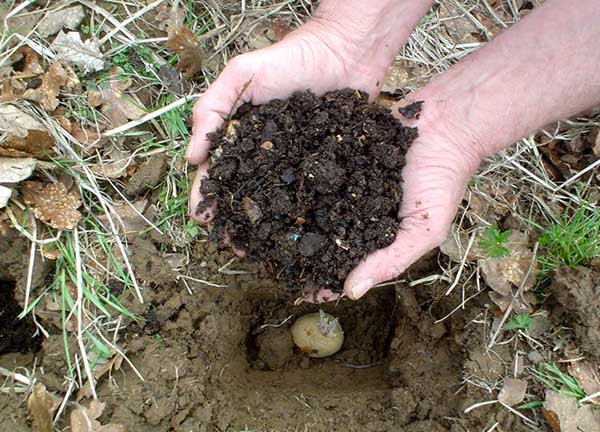
Content
What fertilizers are required for potatoes and signs of their lack
Many gardeners are interested in what kind of fertilizing are needed for potatoes, and how different nutrients act on it. When growing this crop, the most important role belongs to pre-sowing fertilization of the site, the quality and quantity of the entire crop directly depends on this. Potatoes quickly absorb nutrients from the soil.
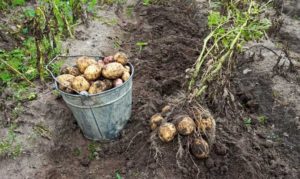
The lack of substances used during growth cannot be compensated for at a time, for this reason, the site needs to be fed (fertilized) twice - for the autumn digging of the beds and when planting tubers.
Important! Foliar (leaf) dressing is also allowed during the growing season.
Fertilizers: mineral and organic
First of all, organic fertilizers are important for potatoes - good compost, rotted manure (humus), bone meal, wood ash etc.
By the way! An excellent result is given siderates.
From mineral fertilizers it is best to use:
- urea, ammonium nitrate;
- calcium nitrate;
- potassium sulfate (potassium sulfate);
- superphosphate;
- nitroammofosk.
- diammofosku.
Advice! One should try not to use chlorine fertilizers and not to give large doses of nitrogen.
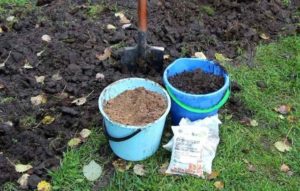
Mineral fertilizers
Potato yield primarily depends on completeness of nutrition, because the culture requires all the basic macro- and microelements.
- So, nitrogen is required for potatoes for rapid growth and a set of aboveground green mass (stems).
Important! However, you should not abuse nitrogen fertilizers, otherwise the stems and leaves will grow, and not the tubers. And, of course, in this case, a normal harvest should not be expected.
- Phosphorus ensures the full development of the root system and shoots.
- Potassium regulates the development of basic metabolic processes associated with adverse conditions in the early stages of development.
Important! Naturally, in addition to the main macronutrients, potatoes should be fully provided with trace elements, especially boron, molybdenum, zinc, copper, calcium and manganese.
Organic fertilizers
Organic fertilizers also contain all the trace elements necessary for potato growth.
The main organic fertilizers for potatoes are different types of manure (preferably rotted = humus), composted plant residues (compost), bone meal, wood ash and siderates.
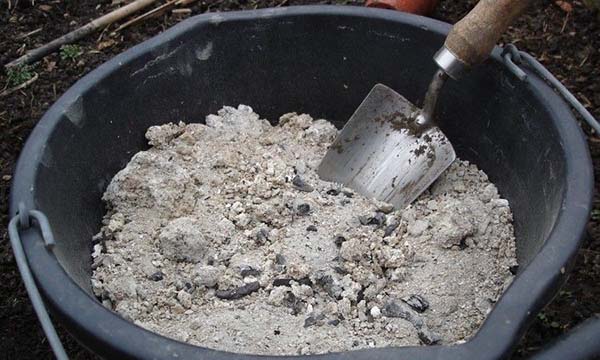
- So, in wood ash contains a lot of potassium, and there are also several important trace elements necessary for the proper development of root crops.
- In bone meal - a lot of phosphorus.
- Manure. It is brought under potatoes only in autumn timeso that all nutrients are absorbed by the soil during the winter period. They do this before digging up the site, it is scattered in advance over the beds at 5-10 kg / m2.
Please note! The introduction of living organic matter in the spring postpones the terms of work and contributes to the reconsolidation of the soil.
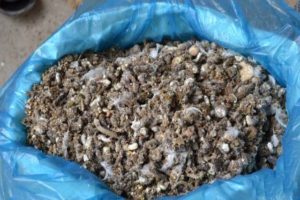
Do not forgetthat just under the potatoes you can add only dry chicken droppings. This is done, as a rule, when landing. Among organic fertilizers, this fertilizer acts the fastest, but it is better to use it in the form of additional fertilizing.
Signs of nutritional deficiencies
Nutrient deficiencies are expressed as follows:
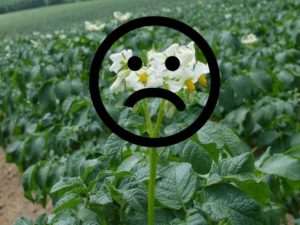
- Nitrogen starvation. It often happens in sandy areas - plants grow poorly, leaves are small in size, pale in color, the lower leaf blades begin to turn yellow. When these signs appear, you need to feed the potatoes with nitrogen fertilizers (it is advisable to sprinkle them).
- Phosphate starvation. Often seen on plants growing in poor areas of high acidity. With a lack of this element, the development of potatoes is delayed, young shoots grow slowly. The bush becomes compressed because the leaves grow at an acute angle. The leaves turn dark green, with a bluish tint; with prolonged phosphorus starvation, a purple hue may appear, the leaves will begin to fade. In this case, foliar phosphorus feeding is desirable.Alternatively, processing potato bushes superphosphate extract... To prevent this trouble, liming of the site is necessary, since in an area with high acidity, phosphorus turns into a form inaccessible to plants.
- Potassium starvation. Mainly appears on light soils, worse in dry and hot weather. You can find out by the dark green color of the leaves. A bronze tint and points of necrotic tissue gradually appear on them. The leaves become wrinkled and begin to curl inward. Short internodes appear on the shoots, they break easily, the plant hardly grows, the appearance of inflorescences is delayed. Tubers become small and elongated, quickly deteriorate during storage. It is necessary to feed the potato bushes with a potassium sulfate solution or other potassium fertilizer along the leaf.
- Calcium starvation. Plants are deficient in calcium in newly developed peatlands. The bushes are delayed in development, and the tops of the shoots become pinkish. The leaves become small, wavy along the edge. The root system is greatly weakened. In this case, it is necessary to make foliar dressing with calcium fertilizer.
- Magnesium starvation. It occurs in potatoes in the rainy season in sandy loam areas. Reduces the amount of starch in tubers and increases the likelihood of late blight disease. The lower leaves turn yellow, necrosis begins from the upper part of the leaves and continues to the center of the leaf, they turn brown and crumble. When these signs appear, potato bushes need to be fed with magnesium fertilizers.
- Copper starvation. Spawns on sandy areas. Plants develop slowly, the leaves turn yellow and gradually wither. It is necessary to treat with copper-containing substances.
- Manganese starvation. It appears on alkaline soils and peat bogs, the yield of plants decreases. They begin to get sick with bacteriosis, the leaves grow small with light spots. With a strong deficiency, necrotic spots appear, the development of shoots stops. It is necessary to feed with manganese products.
- Boric starvation. Mostly on light soils. Potatoes grow shoots with short internodes, for this reason the plant is outwardly dense and squat. Disease resistance drops sharply, small tubers with cracks grow, the pulp becomes watery. When these symptoms appear, the soil and plants are immediately treated boric acid solution.
Video: what boron will give when growing potatoes
Keep in mind that too much nutrient can lead to unbalanced potato development and reduced yield. Most often this happens in plants with too high doses of nitrogen, which leads to their "fattening" - too active growth of green mass with a delay in the growth of tubers. In such a situation, potassium and phosphorus nutrition is enhanced, which makes it possible to improve metabolism.
How and what to fertilize the soil before planting potatoes in the hole
In autumn
Organic fertilizers for the beds where potatoes will grow should be applied in the fall. This allows you to save precious time in spring, and what is very important, during the winter, organic substances will be overcooked and absorbed well by potatoes. Organic matter (manure) must be applied to a plot of 5-10 kg per square meter, it is evenly scattered over the beds before digging. It is also advisable to introduce in the fall superphosphate (better double) and potassium sulfate:
- The rate of potassium sulfate (potassium sulfate) is 25-30 grams per 1 sq. M;
- The norm of superphosphate is 40-70 grams per 1 sq.m.
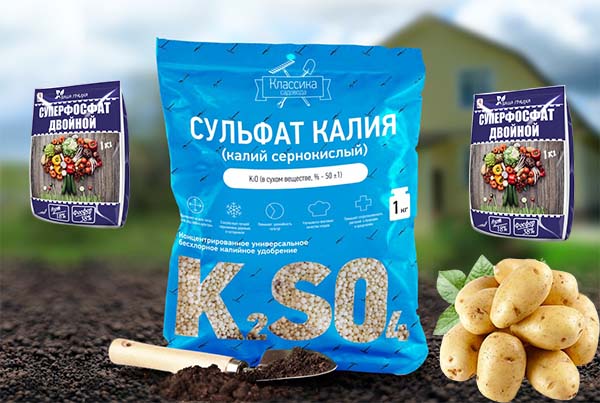
Attention! Top dressing doses depend on the fertility of your soil.
In the spring
Fertilizer doses for spring feeding of potatoes.
Digging:
- Potassium sulfate (potassium sulfate) - 25-30 grams per 1 sq. M;
- Nitroammofoska - 20-30 grams per 1 sq.m.
- Ammonium nitrate - 20-50 grams per 1 sq.m.
When landing:
- Nitroammofoska - 4-5 grams per hole;
- Ash - a handful;
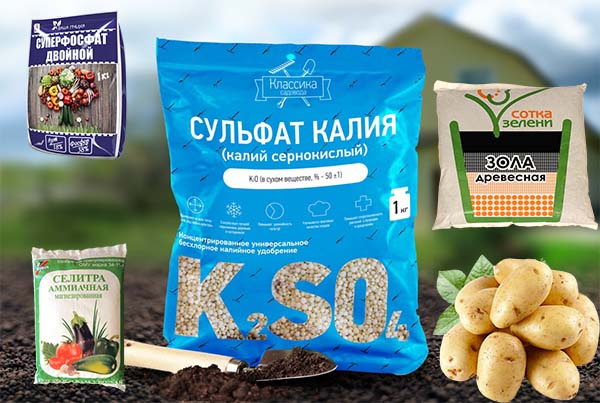
Plants are additionally fed calcium nitratewhen the tops rise to 12 cm.Most often, this time comes along with the first hilling.
Video: feeding potatoes with ammonium nitrate
Fertilizing during planting
If you prefer to use organic fertilizers on the site, then a handful is poured over the tubers into the hole before planting wood ash and a little more humus. From mineral fertilizers, superphosphate is added to the wells. Purchased fertilizers are applied according to the instructions on the package.
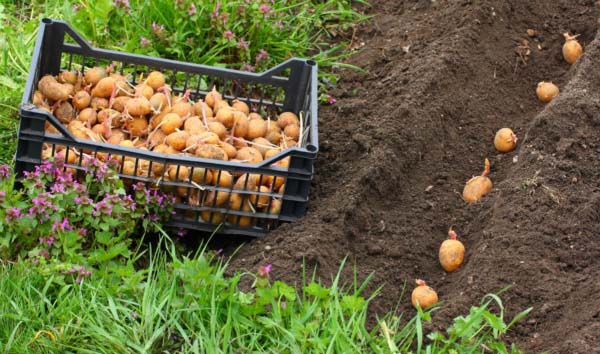
Fertilizing after planting
It is desirable that the potato bushes assimilate all the fertilizers received, for this reason they must be additionally applied after planting the tubers and as deeply as possible. If top dressing is on the surface of the soil, then many nutrients will not be able to be absorbed by the roots. In small areas, they are fed using the "under stake" method. To do this, a wooden stake is hammered between 3 plants. Then it is pulled out and liquid top dressing is poured into the recess. The hole is then covered up.
Recommendation! Top dressing, combined with hilling, helps to preserve rapidly volatilizing nutrients (for example, nitrogen).
Video: feeding and hilling potatoes
First feeding. The first time you need to feed the potatoes 10-15 days after planting. If the development of plants slows down and the leaves become pale, then you need to feed the plants with an increased dose of nitrogen fertilizers. To prepare a root-safe top dressing, 0.5 kg of cow dung is soaked in 1 bucket of water. About 500 ml of the solution is poured onto each plant.
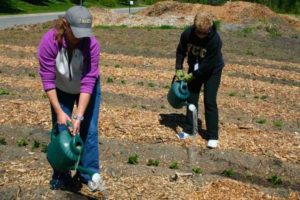
Second feeding. The second time the plants are fed without nitrogen fertilizers, during this period tubers begin to appear and grow. It is necessary to feed the bushes with potash and phosphorus fertilizers. Mix 15 g of superphosphate and potassium sulfate, all this is dissolved in 1 bucket of water.
Third feeding. The last time the potatoes should be fed 3 weeks before harvest. This will enrich the roots with vitamins and nutrients that are required to extend shelf life. For this, a complex organomineral fertilizer is prepared. It contains 25 gr. superphosphate and 0.25 l of manure, this dose is dissolved in 1 bucket of water.
Video: fertilizing and feeding potatoes
Foliar dressing
Frequent root dressing sometimes does not pay off. Foliar feeding of potatoes is more beneficial and effective.
When carrying out them, you need to take into account the characteristics of the plant:
- The outer part of the sheet consists of layers.
- The epidermis of the leaf blade is well protected by a waxy film.
This can delay the penetration of essential compounds when foliar feeding.
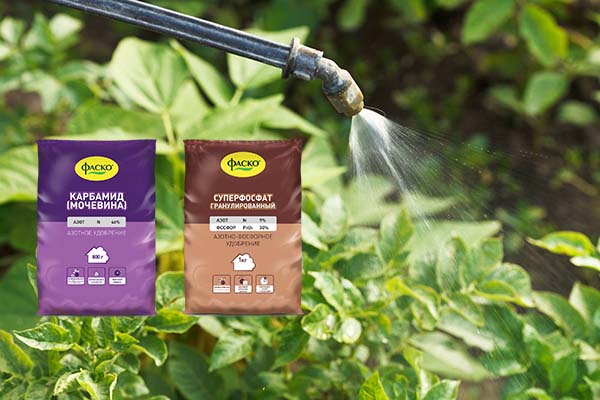
Growing potatoes must be processed in this way:
- Urea. The emerging seedlings are sprayed with carbamide, this substance contains a large amount of nitrogen, which is needed for growth.
- Humates. Humic acids are very useful for potatoes throughout the growing season, the first time the plants are treated after the formation of the first leaves.
- Phosphorus. This element is necessary for potatoes during the formation of tubers. Dissolve in 1 bucket of water 30-40 gr. superphosphate and process the plants.
Regular and correct feeding of potatoes makes it possible to get a good harvest and store a lot of tubers for the winter. So the gardener will receive delicious potatoes that will be stored until spring.
Video: growing potatoes - when and what to feed

